Effects of COVID-19 on the Australian Economy: Insights into the Mobility and Unemployment Rates in Education and Tourism Sectors
Abstract
:1. Introduction
2. Materials and Method
- Cat-1: Effects of COVID-19 on international travel patterns and movement of passengers;
- Cat-2: Effects of COVID-19 on the tertiary education sector and associated unemployment;
- Cat-3: Effects of COVID-19 on tourism and associated unemployment;
- Cat-4: Effects of COVID-19 on the labor market and associated unemployment.
- Published in or after 2021;
- English language only;
- Article type should be research paper, review, or book chapter only;
- No duplicates.
3. Results
3.1. Effects of COVID-19 on International Travel Pattern and Movement of Passengers
3.2. Effects of COVID-19 on the Tertiary Education Sector and Associated Unemployment
3.3. Effects of COVID-19 on Tourism and Associated Unemployment
3.4. Effects of COVID-19 on Labor Market and Associated Unemployment
3.4.1. Unemployment Rates in Australia
3.4.2. Unemployment Rates in States and Territories
4. Discussion
5. Conclusions
Author Contributions
Funding
Institutional Review Board Statement
Informed Consent Statement
Data Availability Statement
Conflicts of Interest
References
- Bialek, S.; Boundy, E.; Bowen, V.; Chow, N.; Cohn, A.; Dowling, N.; Ellington, S.; Gierke, R.; Hall, A.; MacNeil, J.; et al. Severe outcomes among patients with coronavirus disease 2019 (COVID-19)—United States, 12 February–16 March, 2020. Morb. Mortal. Wkly. Rep. 2020, 69, 343. [Google Scholar]
- Qadir, Z.; Munir, A.; Ashfaq, T.; Munawar, H.S.; Khan, M.A.; Le, K. A prototype of an energy-efficient MAGLEV train: A step towards cleaner train transport. Clean. Eng. Technol. 2021, 4, 100217. [Google Scholar] [CrossRef]
- COVID-19 National Incident Room Surveillance Team. COVID-19, Australia: Epidemiology Report 16 (Reporting week to 23: 59 AEST 17 May 2020). Commun. Dis. Intell. 2020, 44, 1–31. [Google Scholar]
- Sourdin, T.; Meredith, J.; Li, B. Digital Technology and Justice; Routledge: London, UK, 2020. [Google Scholar] [CrossRef]
- Munawar, H.S.; Ullah, F.; Khan, S.I.; Qadir, Z.; Qayyum, S. UAV assisted Spatiotemporal Analysis and Management of Bushfires: A Case Study of the 2020 Victorian Bushfires. Fire 2021, 4, 40. [Google Scholar] [CrossRef]
- ABC. Coronavirus Pandemic Means Some Australian Workers Are Busier Than Ever. 2020. Available online: https://www.abc.net.au/news/2020-04-12/coronavirus-work-for-truck-driverssupermarket-workers-cleaners/12142448 (accessed on 6 June 2021).
- ABC. Coronavirus Disease (COVID-19) Advice for the Public: Myth Busters. 2020. Available online: https://phabc.org/coronavirus-disease-covid-19-advice-for-the-public-myth-busters-from-who/ (accessed on 9 June 2021).
- Munawar, H.S.; Hammad, A.W.A.; Haddad, A.; Soares, C.A.P.; Waller, S.T. Image-Based Crack Detection Methods: A Review. Infrastructures 2021, 6, 115. [Google Scholar] [CrossRef]
- ABC. Academics in Talks to Take Pay Cuts to Save Thousands of University Jobs during Coronavirus Pandemic. 2020. Available online: https://www.abc.net.au/news/2020-05-13/universitiesand-union-negotiate-pay-cuts-save-jobs-coronavirus/12239448 (accessed on 16 July 2021).
- Olsen, S.J.; Azziz-Baumgartner, E.; Budd, A.P.; Brammer, L.; Sullivan, S.; Pineda, R.F.; Fry, A.M. Decreased influenza activity during the COVID-19 pandemic—United States, Australia, Chile, and South Africa, 2020. Am. J. Transplant. 2020, 20, 3681–3685. [Google Scholar] [CrossRef]
- Khan, S.I.; Qadir, Z.; Munawar, H.S.; Nayak, S.R.; Budati, A.K.; Verma, K.D.; Prakash, D. UAVs path planning architecture for effective medical emergency response in future networks. Phys. Commun. 2021, 47, 101337. [Google Scholar] [CrossRef]
- Rockett, R.J.; Arnott, A.; Lam, C.; Sadsad, R.; Timms, V.; Gray, K.A.; Sintchenko, V. Revealing COVID-19 transmission in Australia by SARS-CoV-2 genome sequencing and agent-based modelling. Nat. Med. 2020, 26, 1398–1404. [Google Scholar] [CrossRef]
- First Confirmed Case of a Novel Coronavirus in Australia. 2020. Available online: https://www.health.gov.au/ministers/the-hon-greg-hunt-mp/media/first-confirmed-case-of-novel-coronavirus-in-australia (accessed on 15 May 2021).
- Munawar, H.S.; Aggarwal, R.; Qadir, Z.; Khan, S.I.; Kouzani, A.Z.; Mahmud, M.A.P. A Gabor Filter-Based Protocol for Automated Image-Based Building Detection. Buildings 2021, 11, 302. [Google Scholar] [CrossRef]
- Fisk, M.; Livingstone, A.; Pit, S.W. Telehealth in the context of COVID-19: Changing perspectives in Australia, the United Kingdom, and the United States. J. Med. Internet Res. 2020, 22, e19264. [Google Scholar] [CrossRef]
- Seemann, T.; Lane, C.R.; Sherry, N.L.; Duchene, S.; da Silva, A.G.; Caly, L.; Howden, B.P. Tracking the COVID-19 pandemic in Australia using genomics. Nat. Commun. 2020, 11, 4376. [Google Scholar] [CrossRef] [PubMed]
- Akram, J.; Javed, A.; Khan, S.; Akram, A.; Munawar, H.S.; Ahmad, W. Swarm intelligence based localization in wireless sensor networks. In Proceedings of the 36th Annual ACM Symposium on Applied Computing, New York, NY, USA, 22–26 March 2021; pp. 1906–1914. [Google Scholar] [CrossRef]
- Qadir, Z.; Khan, S.I.; Khalaji, E.; Munawar, H.S.; Al-Turjman, F.; Mahmud, M.A.P.; Kouzani, A.Z.; Le, K. Predicting the energy output of hybrid PV–wind renewable energy system using feature selection technique for smart grids. Energy Rep. 2021, in press. [Google Scholar] [CrossRef]
- Australian Bureau of Statistics. Australian Demographic Statistics. 2019. Available online: https://www.abs.gov.au/ausstats/ (accessed on 12 May 2021).
- Australian Government. Coronavirus (COVID-19) Current Situation and Case Numbers. 2020. Available online: https://www.health.gov.au/news/health-alerts/novel-coronavirus-2019-ncov-health-alert/coronavirus-covid-19-current-situation-and-case-numbers (accessed on 18 May 2021).
- Zachreson, C.; Fair, K.M.; Cliff, O.M.; Harding, N.; Piraveenan, M.; Prokopenko, M. Urbanization affects peak timing, prevalence, and bimodality of influenza pandemics in Australia: Results of a census-calibrated model. Sci. Adv. 2018, 4. [Google Scholar] [CrossRef] [Green Version]
- Chen, A.T.; Altschuler, K.; Zhan, S.H.; Chan, Y.A.; Deverman, B.E. COVID-19 CG enables SARS-CoV-2 mutation and lineage tracking by locations and dates of interest. Elife 2021, 10, e63409. [Google Scholar] [CrossRef]
- Munawar, H.S.; Khan, S.I.; Qadir, Z.; Kiani, Y.S.; Kouzani, A.Z.; Mahmud, M.A.P. Insights into the Mobility Pattern of Australians during COVID-19. Sustainability 2021, 13, 9611. [Google Scholar] [CrossRef]
- Eden, J.S. Genome sequencing and its use in public health responses to COVID-19. Microbiol. Aust. 2021, 42, 44–46. [Google Scholar] [CrossRef]
- O’Toole, Á.; Hill, V.; Pybus, O.G.; Watts, A.; Bogoch, I.I.; Khan, K.; Tegally, H.; Giandhari, J.; Pillay, S.; Tumedi, K.A.; et al. Tracking the international spread of SARS-CoV-2 lineages B. 1.1. 7 and B. 1.351/501Y-V2. Wellcome Open Res. 2021, 6, 121. [Google Scholar]
- Munawar, H.S.; Hammad, A.W.A.; Waller, S.T.; Thaheem, M.J.; Shrestha, A. An Integrated Approach for Post-Disaster Flood Management Via the Use of Cutting-Edge Technologies and UAVs: A Review. Sustainability 2021, 13, 7925. [Google Scholar] [CrossRef]
- Variants of Concern. Available online: https://www.cdgn.org.au/variants-of-concern (accessed on 19 July 2021).
- Surveillance for SARS-CoV-2 Variants of Concern in the Australian Context. Available online: https://www.mja.com.au/journal/2021/surveillance-sars-cov-2-variants-concern-australian-context (accessed on 23 July 2021).
- Munawar, H.S.; Ullah, F.; Qayyum, S.; Khan, S.I.; Mojtahedi, M. UAVs in Disaster Management: Application of Integrated Aerial Imagery and Convolutional Neural Network for Flood Detection. Sustainability 2021, 13, 7547. [Google Scholar] [CrossRef]
- COVID-19 in Australia. Available online: https://www.covid19data.com.au/ (accessed on 19 June 2021).
- COVID-19 Cases by Age Group and Sex. 2021. Available online: https://www.health.gov.au/resources/covid-19-cases-by-age-group-and-sex (accessed on 14 May 2021).
- Liaquat, M.U.; Munawar, H.S.; Rahman, A.; Qadir, Z.; Kouzani, A.Z.; Mahmud, M.A.P. Localization of Sound Sources: A Systematic Review. Energies 2021, 14, 3910. [Google Scholar] [CrossRef]
- 1.1 Impact of COVID-19 on the Australian Labour Market: Employment and Unemployment. Available online: https://www.nationalskillscommission.gov.au/11-impact-covid-19-australian-labour-market (accessed on 4 May 2021).
- Fana, M.; Pérez, S.T.; Fernández-Macías, E. The employment impact of the Covid-19 crisis: From short term effects to long terms prospects. J. Ind. Bus. Econ. 2020, 47, 391–410. [Google Scholar] [CrossRef]
- Munawar, H.S.; Khan, S.I.; Anum, N.; Qadir, Z.; Kouzani, A.Z.; Mahmud, M.A.P. Post-Flood Risk Management and Resilience Building Practices: A Case Study. Appl. Sci. 2021, 11, 4823. [Google Scholar] [CrossRef]
- Angelucci, M.; Angrisani, M.; Bennett, D.M.; Kapteyn, A.; Schaner, S.G. Remote Work and the Heterogeneous Impact of COVID-19 on Employment and Health (No. w27749); National Bureau of Economic Research, Inc.: Cambridge, MA, USA, 2020. [Google Scholar]
- Shaukat, M.A.; Shaukat, H.R.; Qadir, Z.; Munawar, H.S.; Kouzani, A.Z.; Mahmud, M.A.P. Cluster Analysis and Model Comparison Using Smart Meter Data. Sensors 2021, 21, 3157. [Google Scholar] [CrossRef] [PubMed]
- Clay, L.A.; Rogus, S. Impact of Employment, Essential Work, and Risk Factors on Food Access during the COVID-19 Pandemic in New York State. Int. J. Environ. Res. Public Health 2021, 18, 1451. [Google Scholar] [CrossRef] [PubMed]
- Munawar, H.S.; Khan, S.I.; Qadir, Z.; Kouzani, A.Z.; Mahmud, M.A.P. Insight into the Impact of COVID-19 on Australian Transportation Sector: An Economic and Community-Based Perspective. Sustainability 2021, 13, 1276. [Google Scholar] [CrossRef]
- Qadir, Z.; Ullah, F.; Munawar, H.S.; Al-Turjman, F. Addressing disasters in smart cities through UAVs path planning and 5G communications: A systematic review. Comput. Commun. 2021, 168, 114–135. [Google Scholar] [CrossRef]
- Reichelt, M.; Makovi, K.; Sargsyan, A. The impact of COVID-19 on gender inequality in the labour market and gender-role attitudes. Eur. Soc. 2021, 23, S228–S245. [Google Scholar] [CrossRef]
- Al-Fadly, A. Impact of COVID-19 on SMEs and employment. Entrep. Sustain. Issues 2020, 8, 629. [Google Scholar] [CrossRef]
- Munawar, H.S. Flood Disaster Management. In Machine Vision Inspection Systems; Wiley: New York, NY, USA, 2020; pp. 115–146. [Google Scholar] [CrossRef]
- Beck, M.J.; Hensher, D.A. Insights into the impact of COVID-19 on household travel and activities in Australia–The early days under restrictions. Transp. Policy 2020, 96, 76–93. [Google Scholar] [CrossRef]
- Li, J.; Vidyattama, Y.; La, H.A.; Miranti, R.; Sologon, D.M. The impact of COVID-19 and policy responses on Australian income distribution and poverty. arXiv 2020, arXiv:2009.04037. [Google Scholar]
- Munawar, H.S. Image and Video Processing for Defect Detection in Key Infrastructure. In Machine Vision Inspection Systems; Wiley: New York, NY, USA, 2020; pp. 159–177. [Google Scholar] [CrossRef]
- Callis, Z.; Seivwright, A.; Orr, C.; Flatau, P. The Impact of COVID-19 on Families in Hardship In Western Australia; The 100 Families WA Project: Perth, Australia, 2020. [Google Scholar]
- Mitchell, W.F.; Watts, M.J. Investing in a Job Guarantee for Australia. In Centre of Full Employment and Equity, Report; Centre of Full Employment and Equity: Callaghan, NSW, Australia, 2020; Volume 2, pp. 1–18. [Google Scholar]
- Munawar, H.S.; Qayyum, S.; Ullah, F.; Sepasgozar, S. Big Data and Its Applications in Smart Real Estate and the Disaster Management Life Cycle: A Systematic Analysis. Big Data Cogn. Comput. 2020, 4, 4. [Google Scholar] [CrossRef] [Green Version]
- Flew, T.; Kirkwood, K. The impact of COVID-19 on cultural tourism: Art, culture and communication in four regional sites of Queensland, Australia. Media Int. Aust. 2021, 178, 16–20. [Google Scholar] [CrossRef]
- Folinas, S.; Metaxas, T. Tourism: The Great Patient of Coronavirus COVID-2019. Int. J. Adv. Res. 2020, 4, 365–375. [Google Scholar] [CrossRef]
- Munawar, H.S. Reconfigurable Origami Antennas: A Review of the Existing Technology and its Future Prospects. Int. J. Wirel. Microw. Technol. 2020, 10, 34–38. [Google Scholar] [CrossRef]
- Ghosh, S. Asymmetric impact of COVID-19 induced uncertainty on inbound Chinese tourists in Australia: Insights from nonlinear ARDL model. Quant. Financ. Econ. 2020, 4, 343–364. [Google Scholar] [CrossRef]
- Munawar, H.S.; Awan, A.A.; Maqsood, A.; Khalid, U. Reinventing Radiology in Modern Era. IJ Wirel. Microw. Technol. 2020, 4, 34–38. [Google Scholar]
- Carlsson-Szlezak, P.; Reeves, M.; Swartz, P. What Coronavirus Could Mean for the Global Economy; Harvard Business Publishing: Boston, MA, USA, 2020. [Google Scholar]
- Munawar, H.S. Applications of Leaky-wave Antennas: A Review. Int. J. Wirel. Microw. Technol. 2020, 10, 56–62. [Google Scholar] [CrossRef]
- Ullah, F.; Sepasgozar, S.M.; Thaheem, M.J.; Al-Turjman, F. Barriers to the digitalisation and innovation of Australian Smart Real Estate: A managerial perspective on the technology non-adoption. Environ. Technol. Innov. 2021, 22, 101527. [Google Scholar] [CrossRef]
- Vandenberg, B.; Livingston, M.; O’Brien, K. When the pubs closed: Beer consumption before and after the first and second waves of COVID-19 in Australia. Addiction 2021, 116, 1709–1715. [Google Scholar] [CrossRef]
- Munawar, H.S. An Overview of Reconfigurable Antennas for Wireless Body Area Networks and Possible Future Prospects. Int. J. Wirel. Microw. Technol. 2020, 10, 1–8. [Google Scholar] [CrossRef] [Green Version]
- Pamidimukkala, A.; Kermanshachi, S. Impact of COVID-19 on field and office workforce in construction industry. Proj. Leadersh. Soc. 2021, 2, 100018. [Google Scholar] [CrossRef]
- Munawar, H.S.; Khalid, U.; Maqsood, A. Modern Day Detection of Mines; Using the Vehicle Based Detection Robot; International Association for Convergence Science & Technology (IACST): Busan, Korea, 2017. [Google Scholar]
- Craig, L.; Churchill, B. Working and caring at home: Gender differences in the effects of COVID-19 on paid and unpaid labor in Australia. Fem. Econ. 2021, 27, 310–326. [Google Scholar] [CrossRef]
- Munawar, H.S.; Zhang, J.; Li, H.; Mo, D.; Chang, L. Mining Multispectral Aerial Images for Automatic Detection of Strategic Bridge Locations for Disaster Relief Missions. In Lecture Notes in Computer Science (Including Subseries Lecture Notes in Artificial Intelligence and Lecture Notes in Bioinformatics); Springer: Cham, Switzerland, 2019; pp. 189–200. [Google Scholar] [CrossRef]
- Boehme, T.; Aitken, J.; Turner, N.; Handfield, R. COVID-19 response of an additive manufacturing cluster in Australia. Supply Chain. Manag. Int. J. 2021, 26, 767–784. [Google Scholar] [CrossRef]
- Churchill, B. COVID-19 and the immediate impact on young people and employment in Australia: A gendered analysis. Gend. Work Organ. 2021, 28, 783–794. [Google Scholar] [CrossRef] [PubMed]
- Munawar, H.S.; Hammad, A.; Ullah, F. After the flood: A novel application of image processing and machine learning for post-flood disaster management. In Proceedings of the 2nd International Conference on Sustainable Development In Civil Engineering (ICSDC 2019), Jamshoro, Pakistan, 28–29 November 2019; pp. 5–7. [Google Scholar]
- Ullah, F.; Al-Turjman, F. A conceptual framework for blockchain smart contract adoption to manage real estate deals in smart cities. Neural Comput. Appl. 2021, 1–22. [Google Scholar]
- Ullah, F.; Sepasgozar, S.M.; Shirowzhan, S.; Davis, S. Modelling users’ perception of the online real estate platforms in a digitally disruptive environment: An integrated KANO-SISQual approach. Telemat. Inform. 2021, 63, 101660. [Google Scholar] [CrossRef]
- Munawar, H.S.; Maqsood, A. Isotropic surround suppression based linear target detection using hough transform. Int. J. Adv. Appl. Sci. 2017, 4, 37–42. [Google Scholar] [CrossRef]
- ‘Regional Universities Are Going to Struggle’: The Unis Worst Hit by COVID-19. Available online: https://www.smh.com.au/national/nsw/regional-universities-are-going-to-struggle-the-unis-worst-hit-by-covid-19-20210622-p583be.html (accessed on 9 July 2021).
- Universities Lost 6% of Their Revenue in 2020—And the Next 2 Years Are Looking Worse. Available online: https://theconversation.com/universities-lost-6-of-their-revenue-in-2020-and-the-next-2-years-are-looking-worse-166749 (accessed on 13 July 2021).
- Munawar, H.S.; Awan, A.A.; Khalid, U.; Munawar, S.; Maqsood, A. Revolutionizing Telemedicine by Instilling H.265. Int. J. Image Graph. Signal Process. 2017, 9, 20–27. [Google Scholar] [CrossRef] [Green Version]
- COVID-19 Recovery for the Tourism Sector. Available online: https://www2.deloitte.com/au/en/pages/economics/articles/covid-19-recovery-tourism-sector.html (accessed on 6 July 2021).
- Tourism Investment Monitor 2019–20: Australian Tourism Investment and COVID-19 Impacts. Available online: https://www.tra.gov.au/data-and-research/reports/tourism-investment-monitor-2019-20/australian-tourism-investment-and-covid-19-impacts (accessed on 9 July 2021).
- Munawar, H.S.; Khalid, U.; Jilani, R.; Maqsood, A. Version Management by Time Based Approach in Modern Era. Int. J. Educ. Manag. Eng. 2017, 7, 13–20. [Google Scholar] [CrossRef] [Green Version]
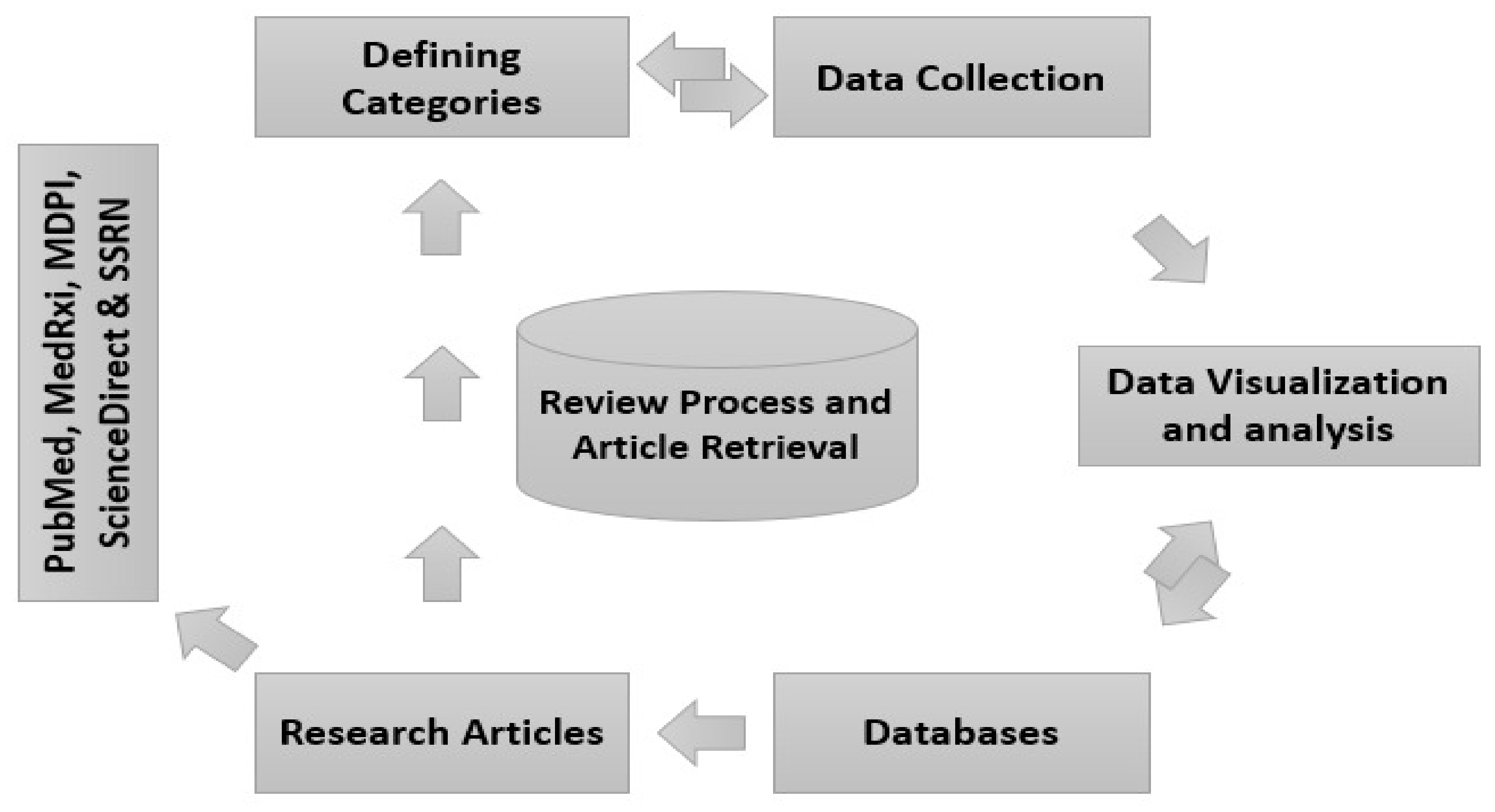
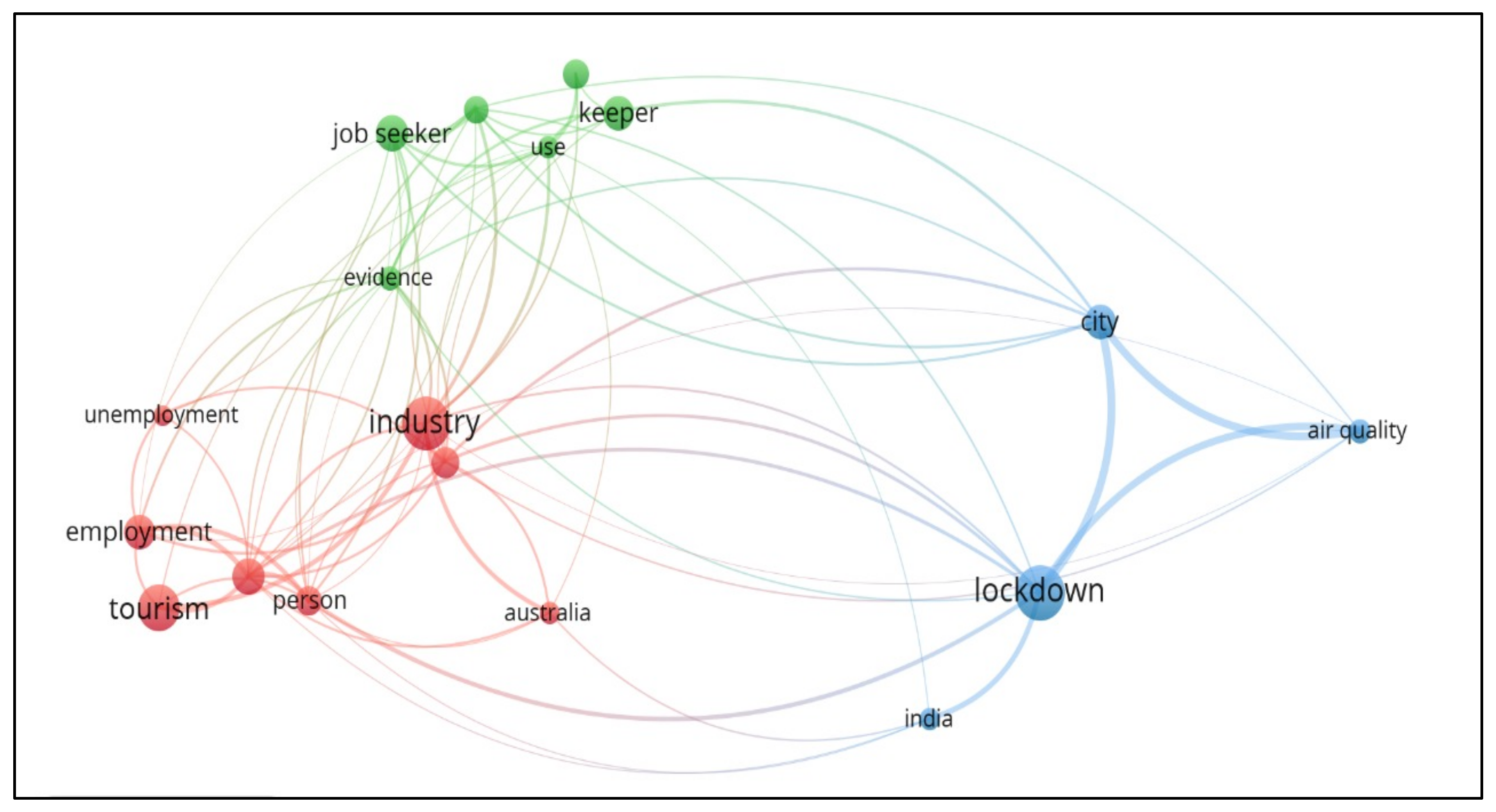
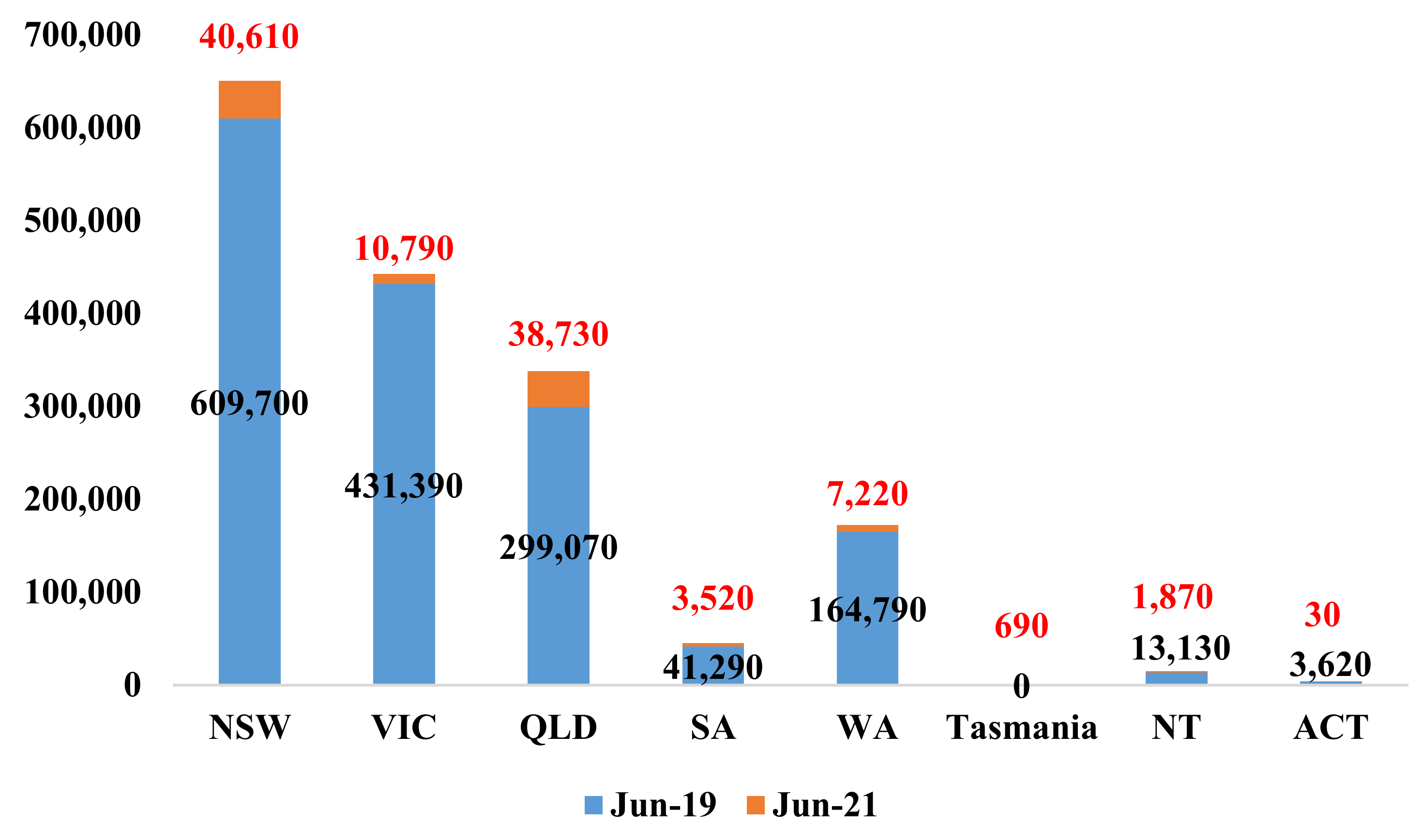
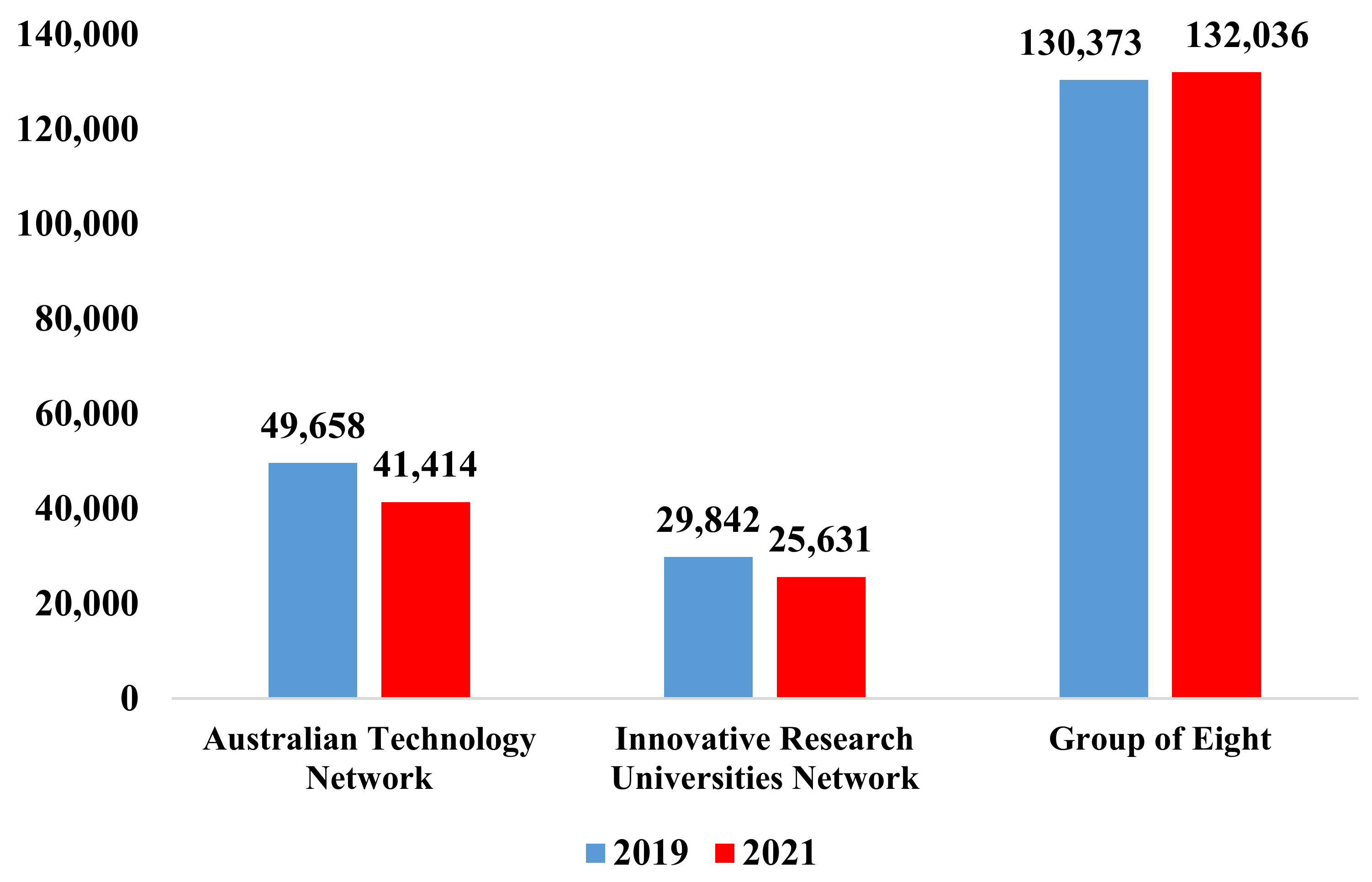

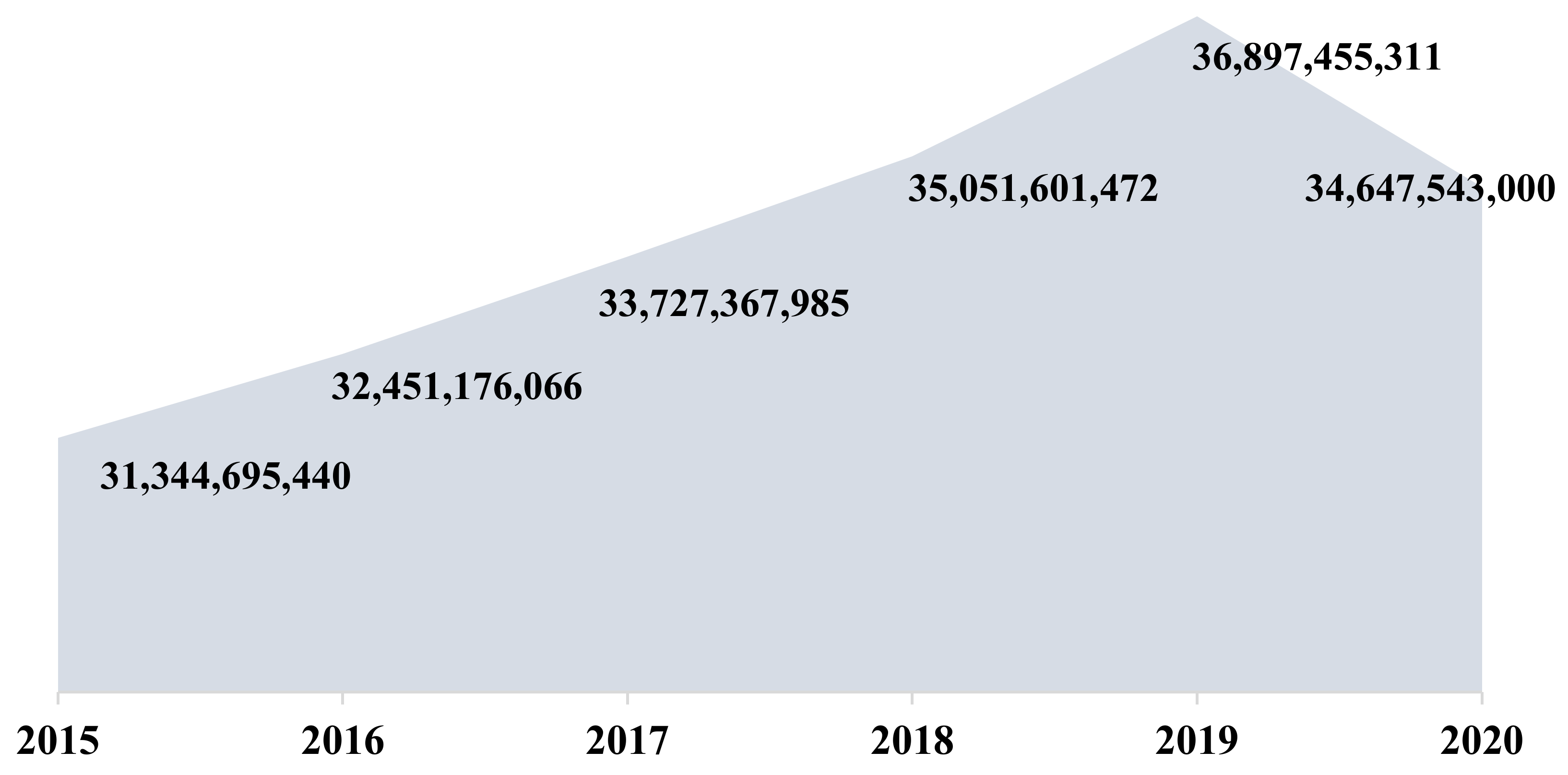
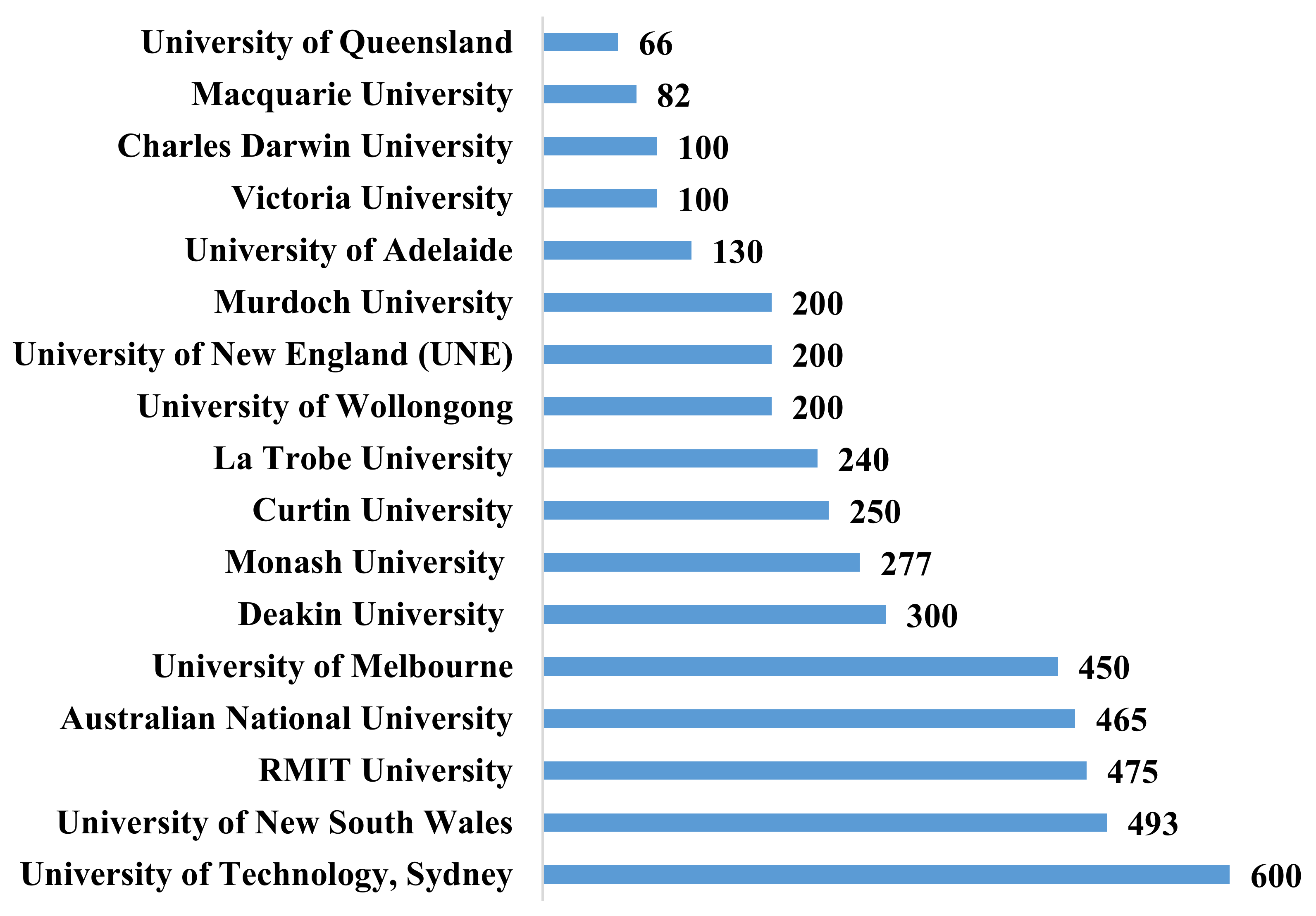
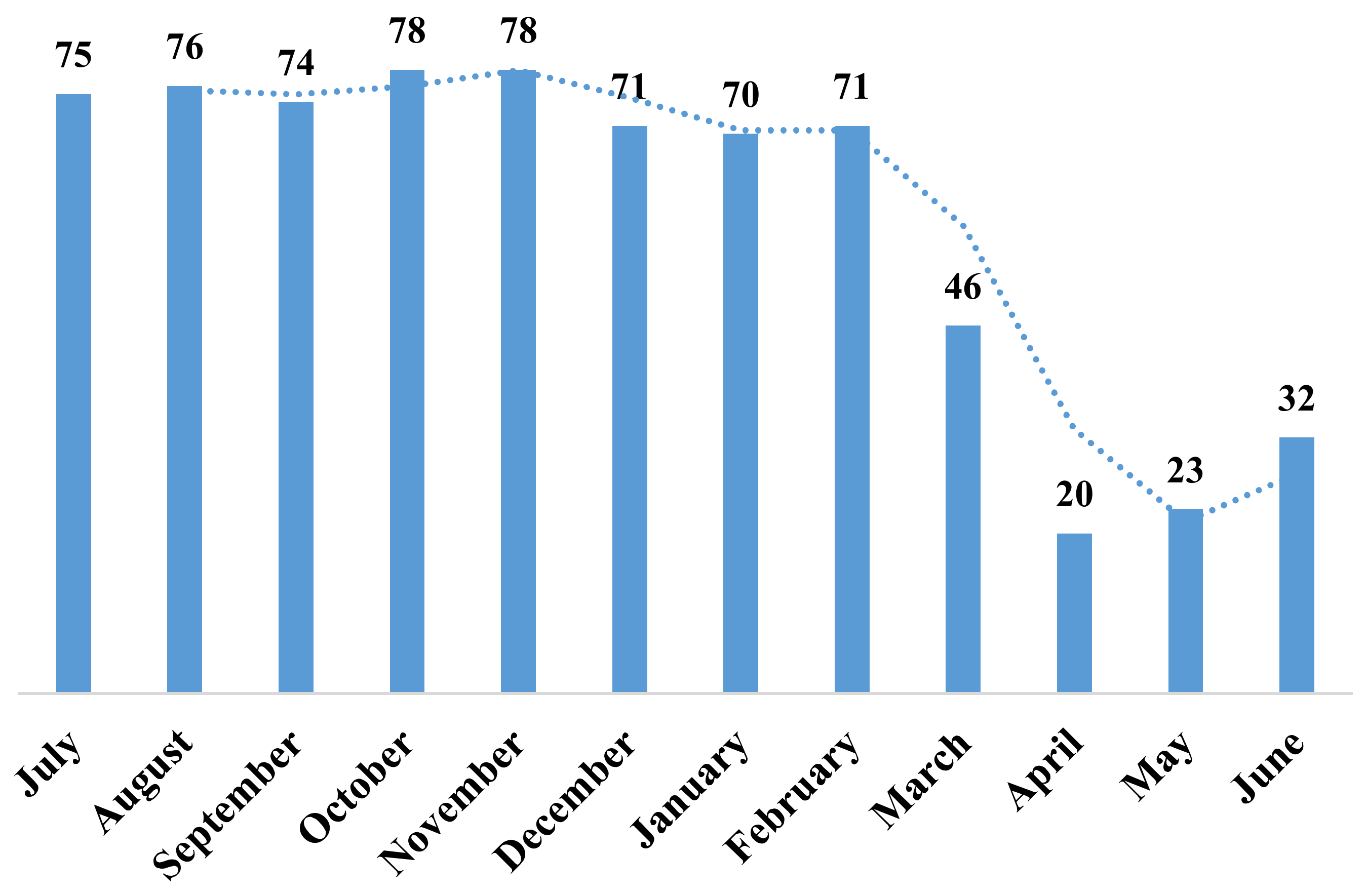
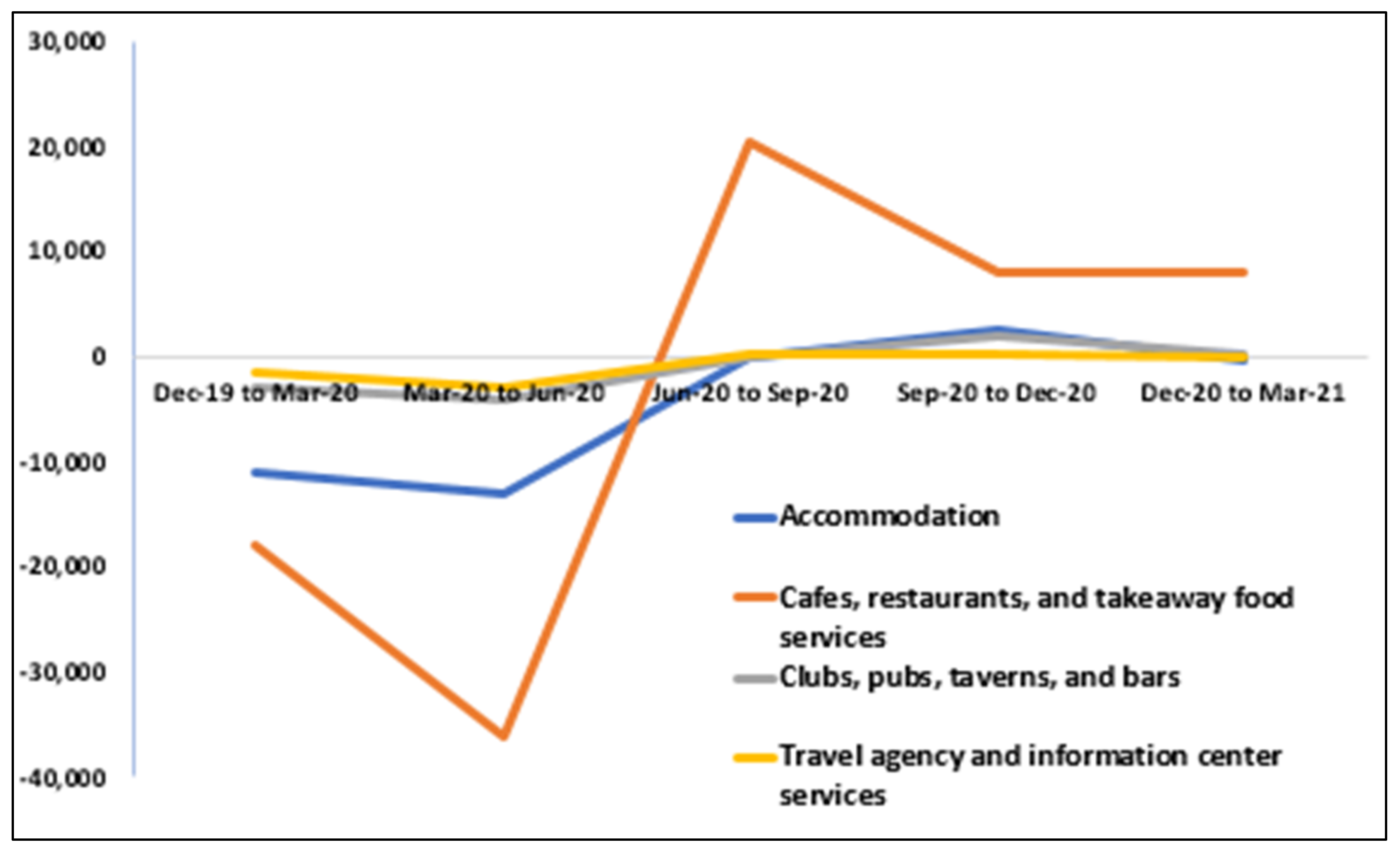
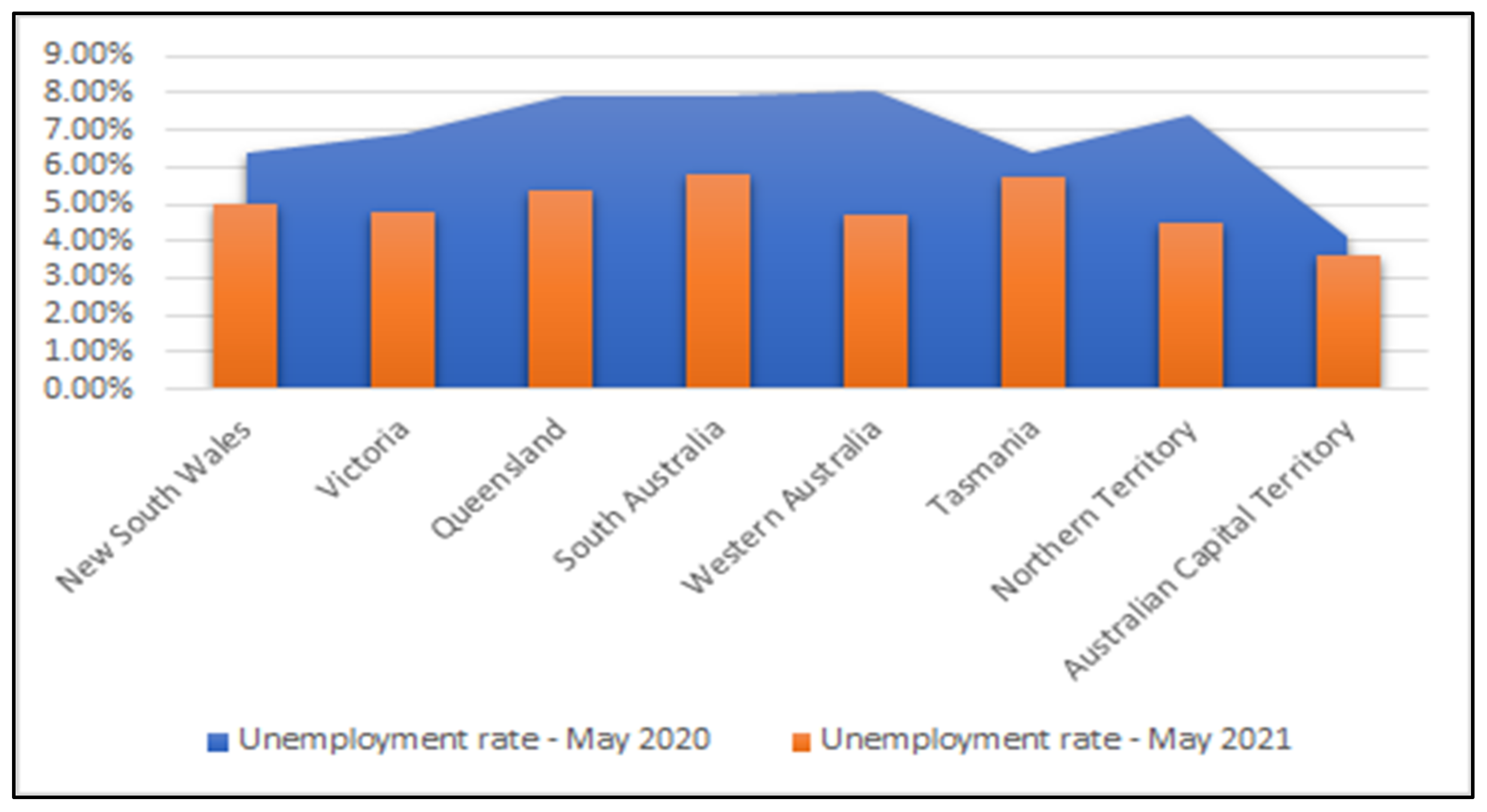
| Country of Citizenship | May-19 | May-20 | Apr-21 | May-21 |
|---|---|---|---|---|
| New Zealand | 152,810 | 2320 | 20,300 | 52,280 |
| UK | 52,270 | 540 | 1190 | 2440 |
| China | 123,570 | 620 | 1540 | 1920 |
| India | 62,220 | 1310 | 1790 | 1400 |
| USA | 56,840 | 300 | 830 | 1080 |
| Philippines | 23,010 | 250 | 570 | 870 |
| Vanuatu | 1060 | 0 | 510 | 600 |
| South Africa | 5110 | 170 | 350 | 460 |
| Japan | 31,050 | 110 | 320 | 420 |
| Malaysia | 51,730 | 80 | 300 | 410 |
| Dec-19 to Mar-20 | Mar-20 to Jun-20 | Jun-20 to Sep-20 | Sep-20 to Dec-20 | Dec-20 to Mar-21 | Mar-20 to Mar-21 | |
|---|---|---|---|---|---|---|
| Tourism | −47,000 (−6.3%) | −91,700 (−13.1%) | 24,700 (4.1%) | 28,400 (4.5%) | 3100 (0.5%) | −35,500 (−5.1%) |
| Whole economy | −118,700 (−0.8%) | −862,800 (−6.0%) | 210,100 (1.5%) | 449,300 (3.3%) | −7500 (−0.1%) | −210,900 (−1.5%) |
| State | Travel Type | 2019 | 2020 |
|---|---|---|---|
| NSW | Intrastate | 60 | −30 |
| Interstate | 30 | −62 | |
| International | 10 | −7 | |
| VIC | Intrastate | 64 | −51 |
| Interstate | 27 | −74 | |
| International | 10 | −75 | |
| QLD | Intrastate | 62 | −22 |
| Interstate | 28 | −75 | |
| International | 10 | −79 | |
| SA | Intrastate | 60 | −16 |
| Interstate | 35 | −73 | |
| International | 6 | −73 | |
| WA | Intrastate | 76 | −12 |
| Interstate | 15 | −76 | |
| International | 8 | −73 | |
| ACT | Intrastate | - | - |
| Interstate | 92 | −55 | |
| International | 8 | −75 | |
| National | Intrastate | 63 | −29 |
| Interstate | 30 | −66 | |
| International | 7 | −76 |
Publisher’s Note: MDPI stays neutral with regard to jurisdictional claims in published maps and institutional affiliations. |
© 2021 by the authors. Licensee MDPI, Basel, Switzerland. This article is an open access article distributed under the terms and conditions of the Creative Commons Attribution (CC BY) license (https://creativecommons.org/licenses/by/4.0/).
Share and Cite
Munawar, H.S.; Khan, S.I.; Ullah, F.; Kouzani, A.Z.; Mahmud, M.A.P. Effects of COVID-19 on the Australian Economy: Insights into the Mobility and Unemployment Rates in Education and Tourism Sectors. Sustainability 2021, 13, 11300. https://doi.org/10.3390/su132011300
Munawar HS, Khan SI, Ullah F, Kouzani AZ, Mahmud MAP. Effects of COVID-19 on the Australian Economy: Insights into the Mobility and Unemployment Rates in Education and Tourism Sectors. Sustainability. 2021; 13(20):11300. https://doi.org/10.3390/su132011300
Chicago/Turabian StyleMunawar, Hafiz Suliman, Sara Imran Khan, Fahim Ullah, Abbas Z. Kouzani, and M. A. Parvez Mahmud. 2021. "Effects of COVID-19 on the Australian Economy: Insights into the Mobility and Unemployment Rates in Education and Tourism Sectors" Sustainability 13, no. 20: 11300. https://doi.org/10.3390/su132011300
APA StyleMunawar, H. S., Khan, S. I., Ullah, F., Kouzani, A. Z., & Mahmud, M. A. P. (2021). Effects of COVID-19 on the Australian Economy: Insights into the Mobility and Unemployment Rates in Education and Tourism Sectors. Sustainability, 13(20), 11300. https://doi.org/10.3390/su132011300








